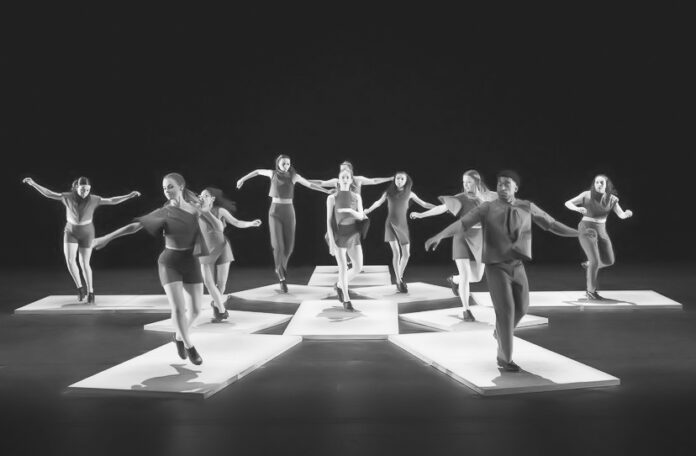On Mar. 30 through Apr. 1, the Muhlenberg dance department staged its 2023 rendition of “In Motion.” The dance performance featured seven pieces, six choreographed by Muhlenberg dance faculty and one by visiting guest artist Melanie George. For the first time ever in a faculty-led dance production, the choreographers were all non-male identifying.
“I feel like this year’s production of ‘In Motion’ is really changing the expectations of dance shows going forward. The dance department did an amazing job of putting on a show that breaks the standards and expectations of what dance can mean and look like. “In Motion” in its entirety was cohesive and powerful,” remarked dancer Lily Knowles ‘23.
The pieces varied enormously in style and theme, and all of them were captivating in their own unique ways. “In Motion” has been in rehearsal since last semester, so finally getting the pieces on stage in front of an audience was rewarding for everyone involved.
“I’m very happy that so many people ended up coming up to me and saying how great it was. It made the two semesters of work on it worth it. It’s been my entire experience at Muhlenberg. I came here two weeks into school, we auditioned for it and started work right away. Now I’m sad that it’s over,” reflected Emma Forster, ‘26.
Each choreographer had a vastly different approach to their pieces. Some of them were very collaborative in their choreography, with dancers sharing that larger portions of what they came up with themselves ended up in the final piece, while others had their own vision that the dancers executed. However, one thing that remained true across the pieces was the clarity with which the truth of the style’s history and the choreographer’s perspective were reflected.
Choreographer of “In Motion”’s tap piece and the production’s co-artistic director, Robyn Watson, reflected, “One of my favorite parts of creating my piece was the chair dance. One thing you should know is that every member of my cast learns everything, even if they may not perform that particular section. I loved creating the chair dance because it goes from a 4/4 time signature to a 5/4 time signature, and it references the historical roots of tap dance.” Audience member Zachary Huseman ‘26 said, “Something I really enjoyed about the tap dance was when they brought out the chairs. The piece was about grief, and tap is usually such a physical dance that utilizes your entire body, but in the chair, they were really only engaged from the knees down, and I thought that was a really interesting reflection of the concepts that the dance was based on. They’re chair tapping not because they’re physically hurt, but because they’re metaphysically hurt—they’re grieving.”
“One of my favorite parts of creating my piece was the chair dance. One thing you should know is that every member of my cast learns everything, even if they may not perform that particular section.”
Co-Artistic Director Robyn Watson
“5/4 [time signature] feels really destabilizing, it doesn’t move the way you expect it to move, and the next bar comes when you aren’t really ready for it. It feels like it really ties into the metaphor of grief and how interrupting it feels; you aren’t ready to lose something,” reflected Anna Item, ‘25.
“For me, the most meaningful part of dancing in ‘In Motion’ was the trust that formed between me, my castmates and Robyn (our choreographer). In ‘The Flesh of Grief,’ we tackled the complexities of grief in a very deep and significant way. Knowing that we could all trust one another to work with this theme in a respectful and safe environment allowed me to explore my own relationship with grief, which in turn has impacted many other parts of my life,” said dancer Marissa Cohen ‘25.
“For me, the most meaningful part of dancing in In Motion was the trust that formed between me, my castmates, and Robyn (our choreographer). In ‘The Flesh of Grief‘, we tackled the complexities of grief in a very deep and significant way. Knowing that we could all trust one another to work with this theme in a respectful and safe environment allowed me to explore my own relationship with grief, which in turn has impacted many other parts of my life,”
Marissa Cohen ’25
As a guest artist, George’s job was to bring something to “In Motion” that none of the faculty could bring. “For me, it was about giving them an experience with my particular approach to jazz dance, which is rooted in a Black American approach, because jazz is a rooted Black American art form,” George told the department for the website. One of the goals of the co-artistic directors of “In Motion,” Heidi Cruz-Austin and Watson, was to find someone who was dedicated to anti-racist practices and would introduce something new to the show. This sentiment was honored in “This Thing Called Jazz”, which utilized four distinct jazz dance styles.
When asked what his favorite part of working with George was, dancer Matthew McCray, ‘24 replied, “Being able to come into a rehearsal space, where I felt free, heard, seen and appreciated. There was a meaning behind every movement, there was a purpose behind every beat.”
“Melanie George came with a clear vision of how jazz is, both in practice and historically, embodied; she executed it beautifully,” said Knowles.
All of the pieces were unique and each stood out in their own right, but like any creative piece, everybody, audience, choreographer and dancer alike, had their own personal favorites to watch.
“Heidi Cruz-Austin’s piece, ‘Wavelength,’ is an epic piece of work and probably my favorite work this year. Heidi is a master at challenging dance forms and presenting life narratives with her work and creating masterpieces. ‘Wavelength’ speaks about the ebb and flows of life while challenging what ballet is, [is] pure genius,” said Watson.
“I loved the use of space in the second piece [“An Appeasement,” choreographed by Natalie Gotter & Dancers]. I thought the sort of motif of confinement or close quarters represented first through the curtain and later through the lighting was really well done,” said audience member Mattea Pappa ‘26.
“I loved the entire performance, it was so amazing to see such a wide variety of dances that were all engaging in their own way! The contrasts between two dances that were in the same style were especially interesting. The two ballet pieces, for example, were both very different but I loved them both for different reasons. I was really engaged in the show and left feeling very inspired!” said Annalise Christie ‘26.
“I have to say that ‘Channels,’ Anito Gavino’s jazz piece, was outstanding. Anito’s use of sound and lighting, combined with the talent and passion of the performers, created a moving piece that told a clear story about the immigrant experience in the United States. Considering the status of Muhlenberg as a [Primarily White Institution], I think it’s an important story to tell at this school, and it was refreshing to see jazz dance represented on stage (in not one, but two different pieces),” reflected Cohen.
“In Motion” was a reflection of tremendous amounts of hard work by everyone involved. It represented multiple stories, cultures and histories all while working to make the Muhlenberg dance department a more progressive and inclusive space for artistry.
Almarah ‘26 is a media & communication and theatre double major with a minor in creative writing and journalism. When not working on the paper, you can find them working with the Muhlenberg Theatre Association or the Muhlenberg Comedy Association. Occasionally they have time to watch any Spider-Man movie.























